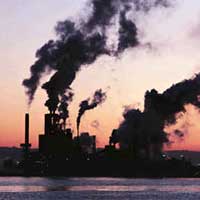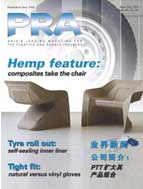 |
 |
E-News Update June 2011 |
LEAD FEATURE |
COMPANY NEWS |
MATERIALS NEWS |
MACHINERY NEWS |
EXHIBITION NEWS |
INJECTION MOULDING ASIA |
PRA June-July 2011 Electronic Issue Now Available |
Materials News
PP the subject of a carbon footprint study
 |
The IHS report, titled Polypropylene's Carbon Footprint: Diverse, with Major Sensitivities - SRI Consulting Carbon Footprint Initiative, examined the carbon footprint of PP from all its primary manufacturing routes, and is the first public study to provide a footprint analysis for bio-PP, which is not currently produced commercially, but is technically feasible.
IHS says the different paths to propylene lead to a diversity of footprints driven primarily by the source of raw materials, which includes crude oil, liquefied natural gas (LNG) or vegetable oil. "These materials, rather than the actual process used to make the polymer, seem to be the key indicator for carbon footprint, and since they vary significantly, so did the resulting footprints. For a given process, the ratio between the highest and the lowest carbon footprints is nearly five to one," says the report.
In sensitivity terms, the 'elephant in the room' for PP footprints are regional variations in crude oil, natural gas and LNG production. For instance, the per/tonne footprint for crude oil production is three to four times greater in Nigeria than in the US. The footprints of Russian gas-based LNGs are three to five times higher than in other parts of the world.
The study was done to identify and clarify this diversity and variation of results, which IHS said is lacking in other public studies currently available. It not only maps the wide array of footprints for this critical product, but also discovered what appears to be a major error in another public study, according to IHS.
Understanding the carbon footprints and greater transparency are essential, the company says, since many producers are now being asked by their customers, who may be consumers and retailers, to account for the carbon footprint of their chemical products across the entire production and manufacturing chain.
A number of different routes - starting with raw materials including crude oil, natural gas liquids or even vegetable oil - are possible to get to propylene. Vegetable oil can be hydro-treated to generate "bio-propane", which is chemically the same as "fossil-based" propane.
Most of the world's propylene is made in refineries or in ethylene crackers where it is typically considered a by-product. Propylene processes are also intentionally being used to increase supplies, which in turn, increases the number of potential sources that need to be examined to understand the range of carbon footprints.
PP is produced by polymerising propylene, sometimes with minor additions of ethylene. It has a wide variety of applications: about one-third of output goes into fibres, another third into injection moulding and another 20% into films and sheets. Other diverse uses include carpets and textiles, automotive and construction components and packaging.
In the IHS study, analysts examined different methodologies for allocating the main sources of emissions - those driven by energy use in refining and those driven by hydrogen use in refining. The latest methodologies for allocating carbon to refined products are separately allocating the impact of the hydrogen based on the amount of hydro-treating required. This raised a question on how hydrogen generation in steam crackers should be accounted for. The company also noted that no footprint credits are currently given to the steam-cracking process for the hydrogen it produces. "To do so would lower the carbon footprint of the steam-cracker considerably - by about one-third to nearly one-half," it says.
While the difference is watered down in PP footprints, it is still meaningful, and compared to the base case for crude-oil refined products that employ the steam-cracker chain to get PP, footprints with a hydrogen-credit for the steam-cracker are lower by as much as 10%.
Meanwhile, although it is made from vegetable oil, bio-propylene has a much higher production footprint than its fossil counterpart, which might be surprising to some. This is a combination of two factors: emissions in the cultivation of the vegetable oil and a high consumption of hydrogen in converting the oil to bio-propane (and its primary product, hydro-diesel). Bio-propane's high footprint rolls through to bio-PP, giving it a far higher footprint than "fossil-based" PP, the study said.
However, this is only cradle-to-plant gate analysis and if both the bio-PP and fossil-based PP are incinerated at the end of their lifetimes, then bio-PP actually shows a 15% lower footprint than fossil-based PP. The difference is that incineration of the fossil-based PP releases carbon into the atmosphere, whereas for the bio-PP, incineration has a footprint of zero because it is presumed to be carbon-neutral.
For more information on the study, please contact sales@ihs.com

